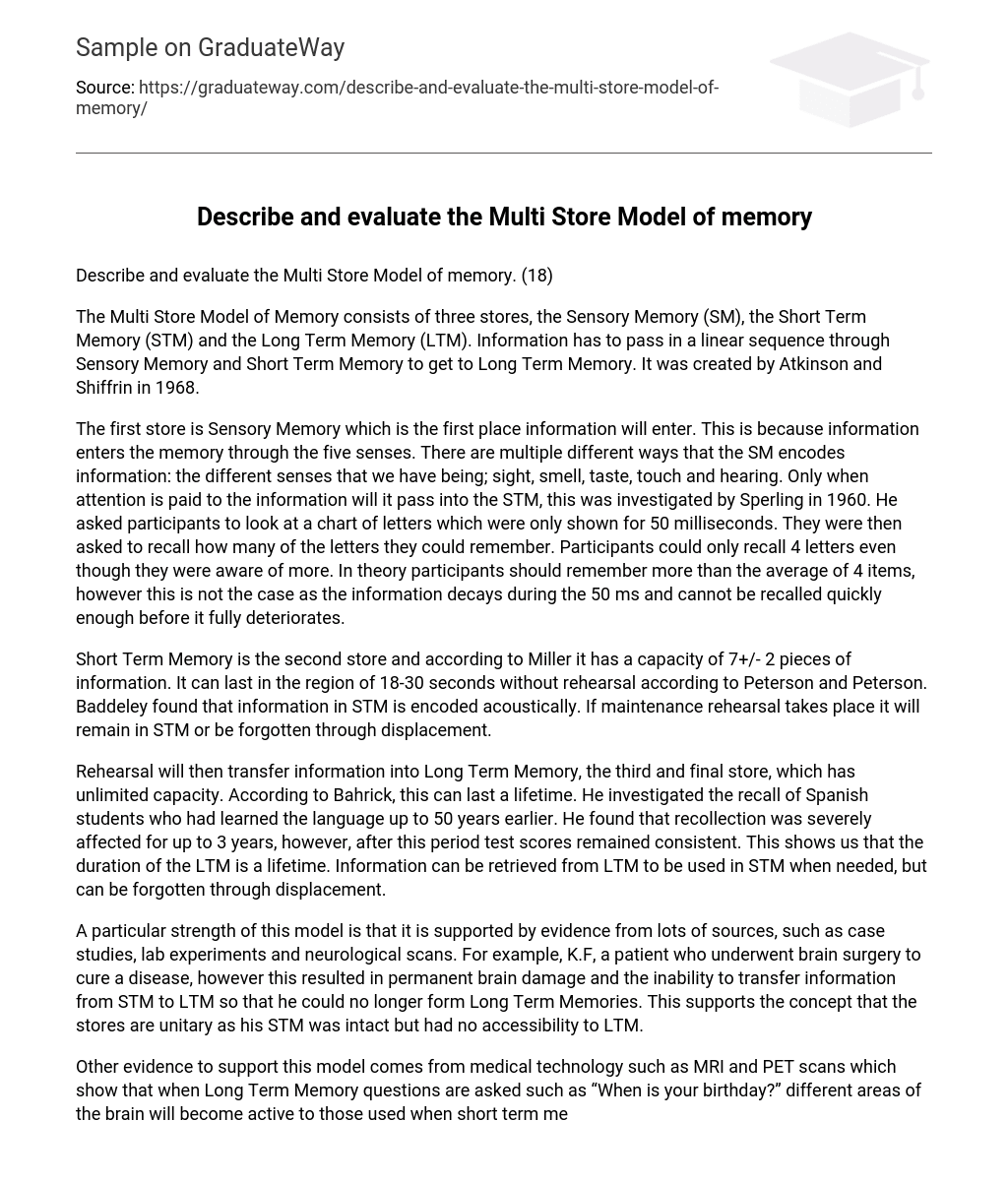Describe and evaluate the Multi Store Model of memory. (18)
The Multi Store Model of Memory consists of three stores, the Sensory Memory (SM), the Short Term Memory (STM) and the Long Term Memory (LTM). Information has to pass in a linear sequence through Sensory Memory and Short Term Memory to get to Long Term Memory. It was created by Atkinson and Shiffrin in 1968.
The first store is Sensory Memory which is the first place information will enter. This is because information enters the memory through the five senses. There are multiple different ways that the SM encodes information: the different senses that we have being; sight, smell, taste, touch and hearing. Only when attention is paid to the information will it pass into the STM, this was investigated by Sperling in 1960. He asked participants to look at a chart of letters which were only shown for 50 milliseconds. They were then asked to recall how many of the letters they could remember. Participants could only recall 4 letters even though they were aware of more. In theory participants should remember more than the average of 4 items, however this is not the case as the information decays during the 50 ms and cannot be recalled quickly enough before it fully deteriorates.
Short Term Memory is the second store and according to Miller it has a capacity of 7+/- 2 pieces of information. It can last in the region of 18-30 seconds without rehearsal according to Peterson and Peterson. Baddeley found that information in STM is encoded acoustically. If maintenance rehearsal takes place it will remain in STM or be forgotten through displacement.
Rehearsal will then transfer information into Long Term Memory, the third and final store, which has unlimited capacity. According to Bahrick, this can last a lifetime. He investigated the recall of Spanish students who had learned the language up to 50 years earlier. He found that recollection was severely affected for up to 3 years, however, after this period test scores remained consistent. This shows us that the duration of the LTM is a lifetime. Information can be retrieved from LTM to be used in STM when needed, but can be forgotten through displacement.
A particular strength of this model is that it is supported by evidence from lots of sources, such as case studies, lab experiments and neurological scans. For example, K.F, a patient who underwent brain surgery to cure a disease, however this resulted in permanent brain damage and the inability to transfer information from STM to LTM so that he could no longer form Long Term Memories. This supports the concept that the stores are unitary as his STM was intact but had no accessibility to LTM.
Other evidence to support this model comes from medical technology such as MRI and PET scans which show that when Long Term Memory questions are asked such as “When is your birthday?” different areas of the brain will become active to those used when short term memory questions are asked. This also supports Atkinson and Shiffrin’s claims that the LTM and STM are unitary stores.
Research also provides evidence of unitary stores, such as the research on primacy and recency effect. Glanzer and Cunitz (1966) found that participants who were asked to remember lists of words could remember the first and last few words but the words in the middle were less likely to be remembered. This supports the idea that the long term memory and short term memory are unitary stores as the first words in the list have been stored in LTM whereas the last words are still in STM.
In Contrast to this Seitz and Schumann-Hengsteler (2000) stated that the STM and LTM are not unitary stores. furthermore Baddeley and Hitch (1974) showed that short term memory is more than just one simple unitary store and comprises different components: The central executive, visuo-spatial. The model suggests rehearsal helps to transfer information into LTM but this is not essential. Why are we able to recall information which we did not rehearse such as swimming yet unable to recall information which we have rehearsed. Therefore, the role of rehearsal as a means of transferring from STM to LTM is much less important than Atkinson and Shiffrin claimed in their model.
However, much of the scientific evidence which supports the MSM lacks validity because it has been carried out in a laboratory. This creates an artificial environment lacking ecological validity. Also the material participants have to remember is unlike information we have to remember in everyday life, for example a list of random words in Glanzer and Cunitz study, so the results can not necessarily be applied to everyday life. Case studies are only a single person’s experience and therefore cannot be generalised.
Finally, another weakness of this model is that it is a much too simple explanation of a complex process. It explains little about STM and LTM but merely describes them as fixed structures and does not take into account that there are different types of LTM and STM such as episodic memory, semantic memory and procedural memory.





